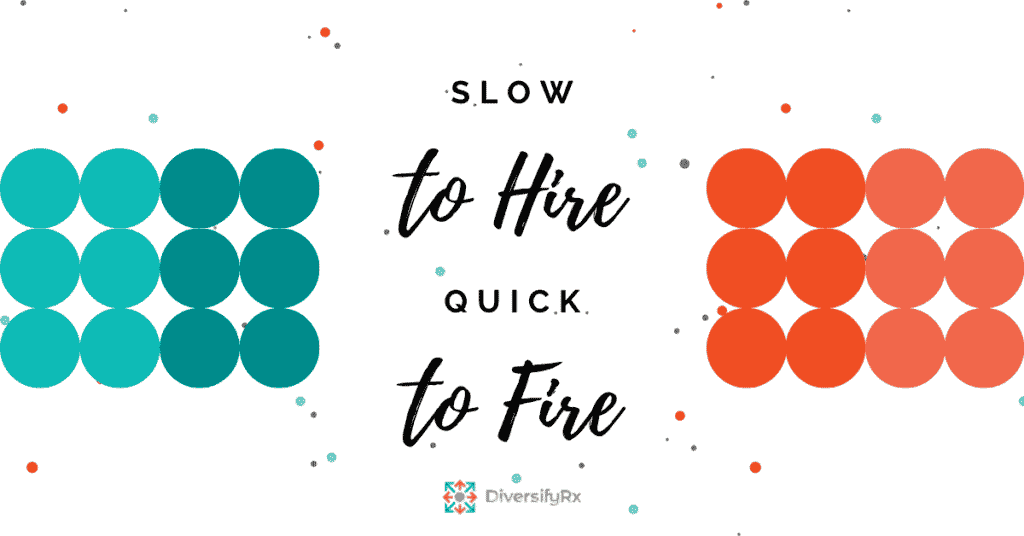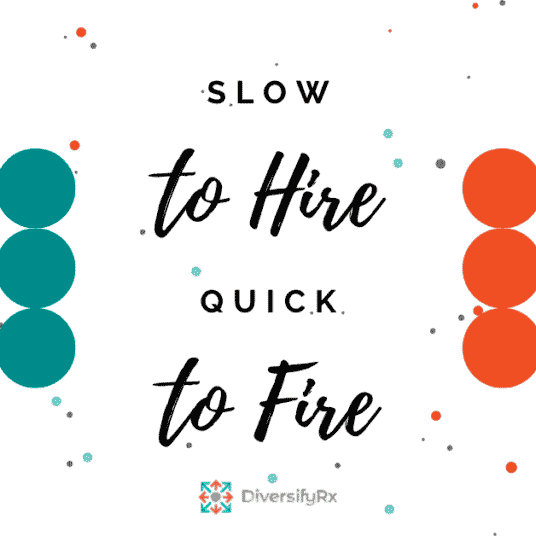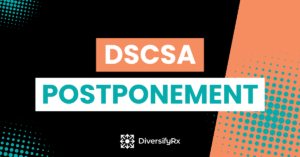Your job as the pharmacy owner is to build a team of high-performing employees.
I didn’t have a mentor in my life until my mid-twenties, and my pharmacy was already a year old. Not having any mentors growing up, I never realized how valuable they are. I learned more from off-the-cuff thoughts from my mentor than any business school could have taught me. He taught me many lessons over the years. The first that I will share with you is one you have probably heard before. A pharmacy owner should be slow to hire and quick to hire.
But what does this mean in real life?
How do you put this into action?
Why should you follow this advice in the first place?
Let’s dive into the details of this pharmacy owner tip.
Slow To Hire, Quick To Fire
This one is hard for many pharmacy owners, including myself. Pharmacists, as a general rule of thumb, are nice people. We don’t like telling people no or involving ourselves in adverse situations. Disciplining, correcting, or terminating employees is most definitely negative. A bad apple of an employee is like an uncontrolled raging wildfire. They will destroy your business in a flash. I learned that your culture is your true competitive advantage. Pharmacy is a commoditized product. CVS, Walgreens, Walmart, and your pharmacy all sell the same products. Their esomeprazole isn’t any better than yours. Where you can pull ahead is your culture.
Your Team Culture
Culture is the driver of the energy in your pharmacy. It affects everything. When your culture is superb, employees look for new opportunities, treat your patients better, earn more referrals, deliver a better experience, look for ways to save expenses, and ultimately build a more profitable pharmacy. When culture is toxic, you not only miss out on the positives above, but you also dig yourself a hole through bad reviews, loss of business, and a bad reputation. It can take years to recover from the effect of one bad employee.
Slow To Hire
How do you ensure a great culture? You should be slow to hire and quick to fire. Take your time finding the right new employee. Leverage your current team, assessments, interviews, and your gut to make sure your process only allows the good ones through. Have a new hiring process that is standardized and uses many angles. Here is an overview of my process.
- Screening questions sent to all applicants
- Only applicants who answer the screening questions get a call
- Call #1 initial screening
- Call #2 call with a different member of the team
- TTI/DISC assessments
- Working interview
- Job offer
There are purposefully many steps to this process, and the candidates are informed upfront what it looks like. Many opt-out at that stage, which makes me happy. If they can’t handle a multi-step hiring process, they surely can’t handle the dynamic operations of my pharmacy.
Quick To Fire
If your process for hiring is a good one, you generally won’t find yourself needing to fire very often. However, people change, your business changes, everything is dynamic, and you always need to ensure you have the right people in the right seat on your pharmacy business train. I have an optimistic outlook on life. Which generally isn’t a bad thing. When it comes to employees, it makes me tend to give too many “chances” and keep employees around longer than I should have. I learned that I need a structure for myself when dealing with employees that aren’t making the cut.
Before I lay out my process, I want to ensure that you know this process isn’t meant to be a standalone engagement. You should be meeting with your employees regularly and giving feedback, so they know exactly where they stand. I use controlling calendars for regular feedback and communication with employees. The firing process comes into play when an employee’s actions have crossed the line from not performing well to negative performance.
The Fire Ladder
I created this ladder process early in my pharmacy owner career. At the time, I was an employer in California who is very pro-employee and needed a documentation system to fight unemployment claims successfully. Even if you don’t need the documentation for your state, I have found that having a process creates a good formality for you and the employee. When dealing with an employee negatively, I highly recommend that you always have a third party in the room. This extra person could be another manager, co-owner, or even a camera phone. In our litigious culture, you need to protect yourself.
As with all processes, you need to consider nuances and ensure you are following any state laws. I used a local HR attorney when creating my employee handbook and my hiring and firing systems. It was a little bit of money that was well worth the expense. Here’s an overview of my fire ladder.
- In the moment correction.
- Write-up of the situation signed by all parties.
- A detailed explanation of the consequences of continued poor behavior.
- Document re-training of the employee.
- Write-up again if required.
- Final written warning with the result being termination.
- Termination following all state laws for PTO, pay, benefits, and other factors.
Some actions will immediately bring the employee to the top of the ladder. If an employee violates HIPAA or pharmacy law, for instance, then you can skip the ladder. It is best practice to have this process laid out in your employee handbook, signed by all new employees.
If you want a copy of my old handbook from my first pharmacy in California that is now closed, just fill out the short form below and download it instantly. This sample handbook should not be used for your pharmacy without necessary adjustments for your personal preferences and your state legal requirements. **Note: You will be directed to download the document. Ensure your pop-up blocker is disabled**
You can always email us at in**@*********rx.com follow us on Facebook or LinkedIn.



















